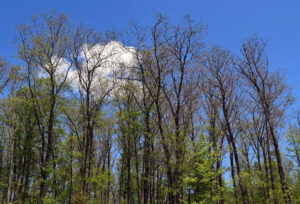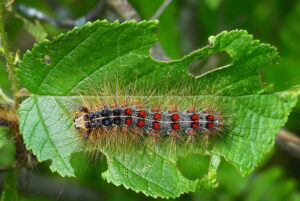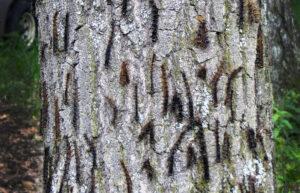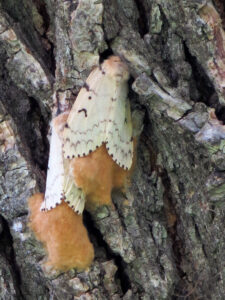By Bill McNee, DNR Forest Health Specialist, Oshkosh;
Bill.McNee@wisconsin.gov or 920-360-0942

Spongy moth defoliation in Marinette County in mid-June 2024. / Photo Credit: Darrek Sams, Wisconsin DNR
As of early July, we have seen a mix of live and dead caterpillars and tree defoliation that is typical of a late-stage spongy moth outbreak. Reports of defoliation have been received as far north as Florence County.
Recent aerial surveys in southern Wisconsin spotted defoliation in the same general areas as in 2023, but the defoliation has generally been less intense this year. Information for northern Wisconsin has yet to be made available. Refoliating oaks, growing a second set of pale-looking leaves, were seen in Walworth County in early July.

A mature spongy moth caterpillar on a leaf. / Photo Credit: Bill McNee, Wisconsin DNR
Some trees that were heavily defoliated in 2023 have a full canopy this summer, but some show partial dieback and others are completely dead. Pockets of heavy oak mortality are present in parts of southern Wisconsin.
The outbreak in the southern counties is likely to be greatly reduced next year. It is too early to predict if a similar drop-off can be expected in northern Wisconsin, although a downward trend is probable given weather conditions and historical patterns. Pockets of high populations will likely linger into 2025 in southern and northern counties.

Caterpillars killed by nucleopolyhedrosis virus (NPV) hang in an inverted “V” orientation; caterpillars killed by the fungus Entomophaga maimaiga hang vertically. / Photo Credit: Wisconsin DNR.
Caterpillar Mortality Observed
DNR staff saw and received many reports of spongy moth caterpillar mortality from nucleopolyhedrosis virus (NPV) and the fungus Entomophaga maimaiga. This increase in mortality was expected, given the age of the outbreak and above-average rainfall so far this year. The two different types of dead caterpillars are commonly seen on the same tree, often filled with a brown, foul-smelling liquid. Heavy rains have been removing these dead caterpillars from trees.
Reported mortality levels have generally ranged from moderate to heavy, with some landowners reporting nearly 100% mortality in the southern counties. Most reports of heavy mortality have come from the southern counties, with other notable reports of moderate and heavy mortality coming from Juneau and Marinette counties. Heavy caterpillar mortality will reduce the severity of next year’s outbreak and cause a population crash during the current year.
Adult Moths Now Present
Wisconsin’s first reports of adult moths came from Walworth and Sauk counties on July 3. Small numbers of live caterpillars were still present when the adults were observed in Walworth County.
Managing Life Stages
The remaining live caterpillars, pupae and female moths can be crushed with a stick or drowned in soapy water. Don’t touch the hairy caterpillars; they can cause skin rashes and welts. Avoid touching the white, non-flying female moth because its potent pheromone (scent) will be transferred to your skin, and brown-colored male moths will be attracted to you.

Female spongy moths lay egg masses in Oshkosh in 2017. / Photo Credit: Bill McNee, Wisconsin DNR
Egg Masses Predict 2025 Population Levels
Newly produced masses are tan-colored and about the size of a nickel or quarter. New egg masses won’t hatch until next spring, leaving plenty of time to examine your trees and determine if you can expect a spongy moth problem in 2025.
Masses safely within reach can be scraped off and drowned in soapy water or sprayed with horticultural oil to kill the eggs inside. Do not scrape them onto the ground because they will still hatch next year.
To predict the severity of an outbreak next year, conduct egg mass surveys this fall when all eggs have been produced. This information will help property owners determine the need for insecticide treatments or other active management.
Property owners should also be on the lookout for newly produced egg masses that are smaller than normal and about the size of a dime. These are often produced by a female moth carrying a sub-lethal dose of the NPV virus. A noticeable proportion of small egg masses is usually a sign that the spongy moth outbreak is trending downward and is past its peak intensity.
Additional Recommendations
Property owners are encouraged to examine their trees and take action. Specifically:
- Visit the Spongy Moth Resource Center for management information.
- Wait to cut down any defoliated trees. Healthy hardwood trees usually produce new leaves a few weeks after defoliation.
- Forest management may need to be postponed in defoliated areas. Trees will be stressed from heavy defoliation and often unable to handle the additional stress from forest thinning.
- Monitor for crown dieback and twolined chestnut borer infestation in trees that have been stressed by drought and defoliation over the past few years.
- Consult an arborist or forester for additional management recommendations. When seeking an arborist, check both directories: Wisconsin Arborist Association and International Society of Arboriculture.
